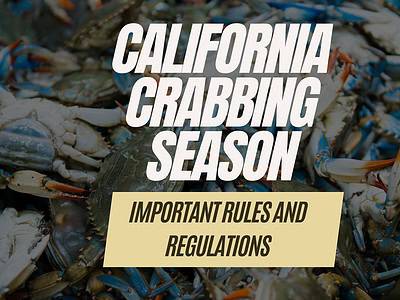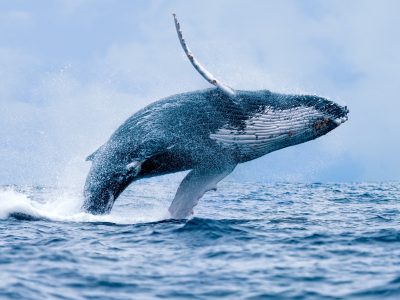Blue Shark
Prionace glauca
Blue sharks can have up to 135 pups at a time.
Advertisement
Blue Shark Scientific Classification
- Kingdom
- Animalia
- Phylum
- Chordata
- Class
- Chondrichthyes
- Order
- Carcharhiniformes
- Family
- Carcharhinidae
- Genus
- Prionace
- Scientific Name
- Prionace glauca
Read our Complete Guide to Classification of Animals.
Blue Shark Conservation Status
Blue Shark Facts
- Prey
- Cephalopods and fish, injured marine mammals
- Group Behavior
- School
- Fun Fact
- Blue sharks can have up to 135 pups at a time.
- Estimated Population Size
- At least 20 million
- Biggest Threat
- Humans
- Most Distinctive Feature
- Its blue coloration
- Other Name(s)
- Blue dog, blue whaler
- Gestation Period
- 9 to 12 months
- Optimum pH Level
- 8.1
- Habitat
- The deep, open ocean
- Predators
- Tiger sharks, great white sharks, orcas, humans, sea lions
- Diet
- Carnivore
- Type
- Fish
- Common Name
- Blue shark
- Number Of Species
- 1
View all of the Blue Shark images!
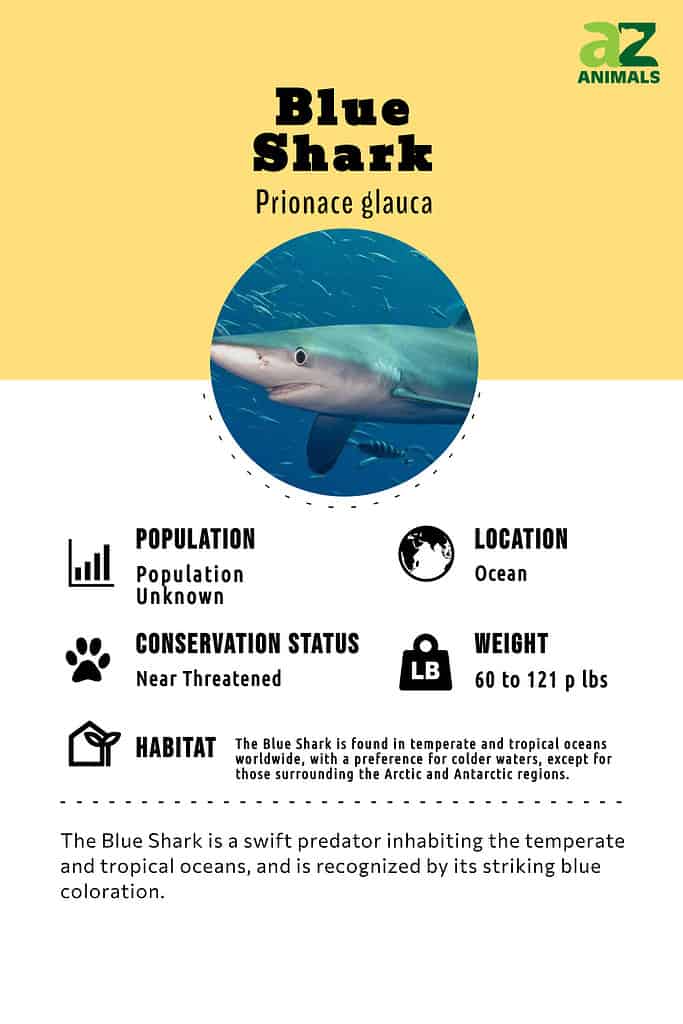
“The Blue Shark is called the most elegant of sharks.”
Slender and beautiful in the way that a shark can be beautiful, the blue shark is found in all the deep seas of the world save the coldest. It is a requiem shark, which means it gives birth to live young, migrates to feeding and breeding areas, and is found in warmer waters, though the blue prefers waters on the coolish side. Characteristics include its big round eyes and unusually long pectoral fins.
Though some can be found in aquariums, blue sharks don’t do well in captivity. They are creatures of the open ocean.
4 Incredible Blue Shark Facts!

A characteristic of sharks is that the female’s skin is twice as thick as the male’s skin, which is an adaptation that safeguards her when he bites her while mating.
©Pommeyrol Vincent/Shutterstock.com
Here are some fascinating facts about and characteristics of the blue shark:
- One of the shark’s adaptations is that the skin of the female shark is twice as thick as that of the male. This protects her when he bites her during mating.
- The blue shark is the most likely shark to be a victim of bycatch. Millions are tangled up in nets and long lines every year.
- Like many sharks, the blue shark can enter a state of tonic immobility, a sort of trance, if it’s taken out of the water and rolled on its back.
- A blue shark baby grows very quickly. It can grow nearly a foot a year until it’s an adult.
Evolution and Origins
The maximum lifespan of blue sharks is currently undetermined, but they are believed to survive for at least 20 years, and their seasonal migrations are commonly linked with fluctuations in water temperature, whereby they move towards northern and inshore areas as the waters warm, with larger females leading the way for smaller males and females.
Blue sharks can be found off the shores of every continent, except Antarctica, and they live in regions as distant as Norway in the north and Chile in the south, with the highest occurrences in the Pacific located between 20° and 50° North, but with significant seasonal variations.
The blue shark (Prionace glauca) roams the temperate and tropical oceans of the world and is distinguished by its radiant blue color on its back and sides, and is recognized for being a swift predator that travels vast distances to prey on squid, bony fish, and carrion from marine mammals.
Classification and Scientific Name
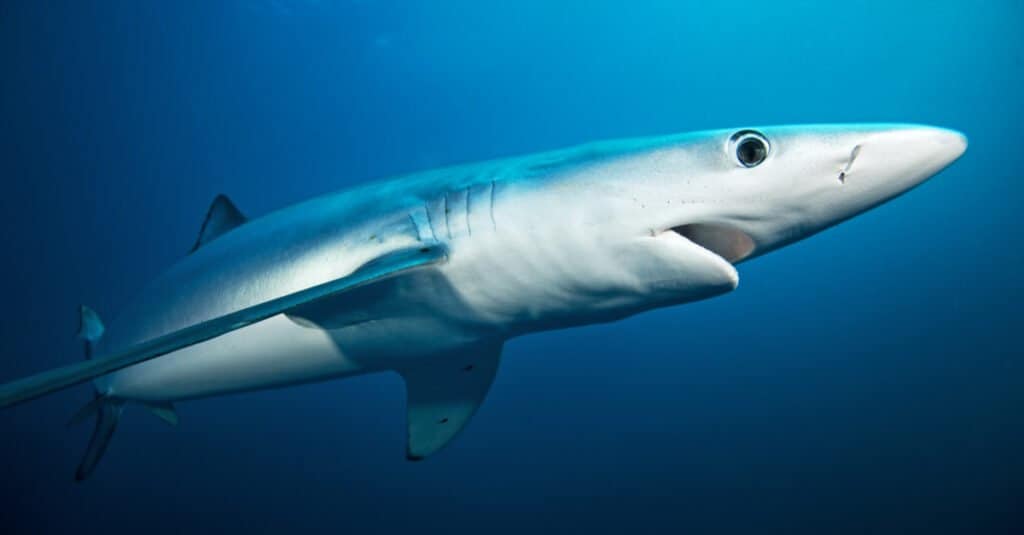
Prionace glauca is the scientific name of the blue shark, where the term Prionace is derived from Greek, with “prion” denoting “saw” and “akis” indicating “point”.
©Martin Prochazkacz/Shutterstock.com
The blue shark’s scientific name is Prionace glauca. Prionace is from the Greek. Prion means “saw” and akis means “point”, which probably refers to the animal’s teeth. Glaucas is Latin for “blue-green” or “blue-gray,” which describes the color of the shark’s body.
Appearance and Adaptations
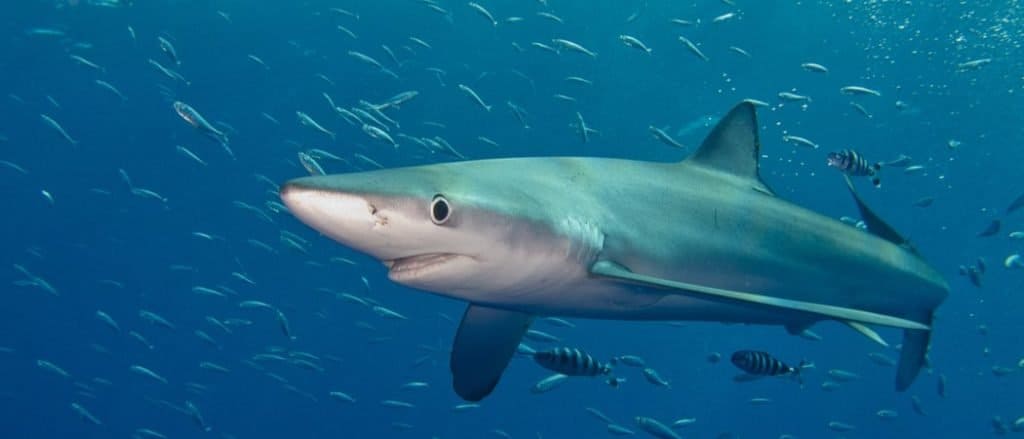
The blue shark is a well-known fish recognized for its attractive coloration and streamlined, sleek body.
©Anna L. e Marina Durante/Shutterstock.com
The blue shark is a sleek, streamlined fish famous for its beautiful coloration. On top, it’s a rich indigo blue, which fades down the flanks to sapphire blue, which further turns to light gray on the belly.
This too is one of the shark’s adaptations, as the coloration makes it hard to see for both predators and prey. Its long tail fin helps it attain speeds of over 40 miles per hour, and it has unusually long pectoral fins.
The mouth is full of very sharp and serrated teeth which are constantly being replaced. A large blue shark can be 12 feet long and weigh 450 pounds, though the heaviest shark found weighed an impressive 862 pounds. Other characteristics are the blue’s senses of smell and touch. As with most other sharks, these senses are highly developed.
Distribution, Population, and Habitat
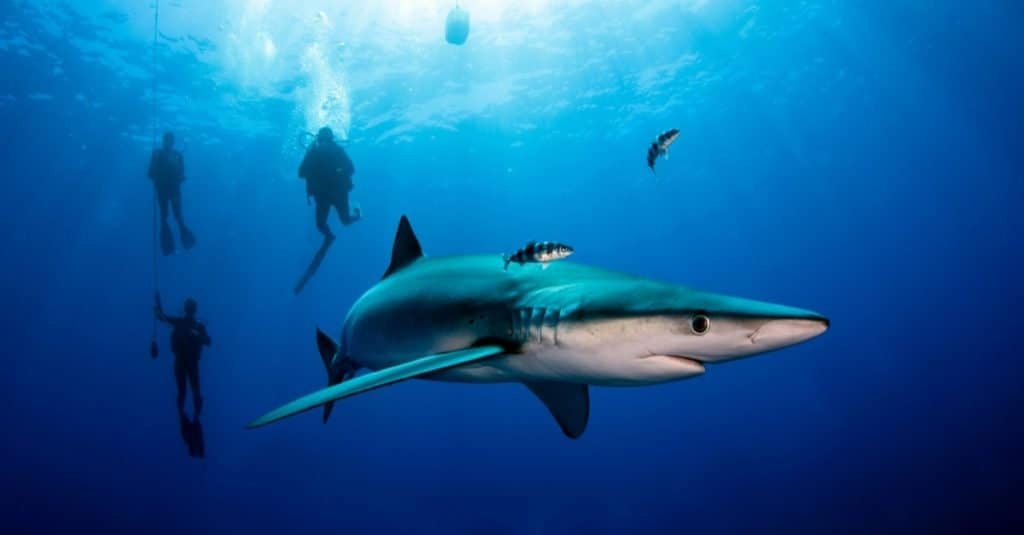
These sharks inhabit the open oceans worldwide, and while they favor colder waters, they avoid the Arctic and Antarctic regions.
©Vladislav Klimin/Shutterstock.com
These sharks are found in open oceans around the world, and though it prefers cooler water, it stays away from the waters around the Arctic and Antarctic. If the water is too warm, as it might be around the equator, it will dive to a level where it’s a bit cooler.
Though millions are caught by accident and on purpose every year and they are near threatened, the population hasn’t decreased much over the last 10 years. This is probably because of the fecundity of female blue sharks, who can have dozens of pups per litter.
Predators and Prey
Humans hunt these sharks for their fins, which go into making shark fin soup, and their meat is used, ironically, to make fish food.
The shark’s hide is turned into leather, and it is sometimes hunted for sport as it puts up a fight. Other predators include larger and more aggressive sharks such as the great white shark and the tiger shark. Killer whales, elephant seals, and sea lions also eat these sharks. Baby sharks are especially at risk.
The blue shark is also parasitized by tapeworms that they get from eating infected fish. Copepods can be so numerous on and in a shark that they can impair its vision and the functioning of its gills.
Prey includes a variety of cephalopods and many species of bony fish, including castor oil fish and snake mackerel. If a seabird is unfortunate enough to be in the same location as a blue shark, the shark may eat it as well.
Reproduction and Lifespan
Location is important for these sharks’ reproduction. In summer, they gather on the continental shelves to mate. To do this, the male has to bite the female to hold her still, as eggs are fertilized internally. The female may store the sperm for some months before she lets it fertilize her eggs.
When she does become pregnant, her next location becomes the Northern Pacific, where she gives birth. The shark is pregnant for about a year, and she can give birth to over 100 pups at a time, though the usual number is between 25 and 50.
A shark baby is independent soon after birth and becomes ready to breed when it’s five to six years old. Female sharks breed every year or so.
The shark’s lifespan in the wild is about 15 years, and it’s cut in half if the shark is held in captivity.
Fishing and Cooking
These sharks aren’t hunted extensively though they’re captured to make shark fin soup, leather, fish food, and for the alleged health benefits of their cartilage. They are mostly bycatch victims.
Population
Since 20 million of these sharks are accidentally caught in nets and long lines yearly and their population is not decreasing, there must be at least tens of millions of them in the wild. Still, their conservation status is near threatened.
View all 285 animals that start with BBlue Shark FAQs (Frequently Asked Questions)
Where are blue sharks found?
Blue sharks are found in the open ocean all around the world.
What is a blue shark?
A blue shark is a kind of requiem shark. No one is quite sure where the name “requiem” came from. It may come from the French word for shark, from the Latin word for “rest,” or from a word that means to bare the teeth in a grimace.
Are blue sharks dangerous to humans?
Blue sharks are not that dangerous to humans. One of the interesting facts about blue sharks is that there have only been 13 reported cases of blue shark attacks on humans in a 400 year period. These attacks usually happened during shipwrecks when humans ended up in the water, and the sharks simply took advantage.
Are blue sharks aggressive?
Blue sharks don’t usually attack humans, but they’re not particularly timid either. They should be treated with respect.
Are blue sharks friendly?
Blue sharks can’t be said to be friendly, but they are curious and may approach a diver to investigate them. They may bite if the diver has been spearfishing and has caught something the shark considers a meal.
What are blue sharks known for?
Blue sharks are known for their fecundity and their beauty.
Where are blue sharks found?
Blue sharks can be found swimming near the surface of the water in the ocean or they dive as deep as 1150 feet.
How big do blue sharks get?
Blue sharks can grow to a size of 13 feet in length and weigh over 528 pounds, though most blue sharks aren’t that big.
Thank you for reading! Have some feedback for us? Contact the AZ Animals editorial team.
Sources
- Florida Museum, Available here: https://www.floridamuseum.ufl.edu/discover-fish/species-profiles/prionace-glauca/
- Pelagic Shark Research Foundation, Available here: http://www.pelagic.org/montereybay/pelagic/blueshark.html
- Wikipedia, Available here: https://en.wikipedia.org/wiki/Blue_shark
- Animal Diversity Web, Available here: https://animaldiversity.org/accounts/Prionace_glauca/








